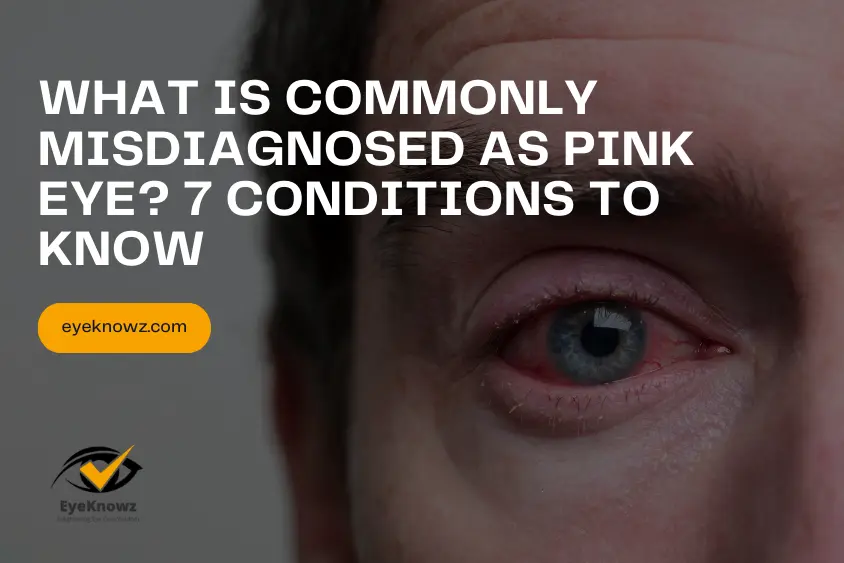You’re concerned about your eyes, and we understand. Pink eye, or conjunctivitis, is a well-known eye problem. But did you know that other eye issues can mimic pink eye, causing more confusion?
Conditions like styes, keratitis, iritis, allergies, or blepharitis might seem alike, but we’re here to help you differentiate between them and ease your eye worries. What is Commonly Misdiagnosed as Pink eye? Stick around; we’ve got your back and your eyes.
Understanding Pink Eye: The Eye’s Red Flag
Pink eye, medically termed MUCOPURULENT CONJUNCTIVITIS, occurs when the thin, transparent layer covering your eye and inner eyelids becomes red and swollen. The causes of this inflammation can be viruses, bacteria, allergies, irritants, or prolonged use of contact lenses. Let’s explore symptoms before delving into the differential diagnosis of various eye conditions.
Common Symptoms of Pink Eye: What to Look Out For
What does pink eye look like? The most common symptom of pink eye is reddened eyes, but not all reddened eyes result from pink eye. People suffering from pink eye often experience the following symptoms:
- Redness in the white of the eye or inner eyelids
- Watery or thick, yellow discharge
- Itchiness or a gritty feeling in the eye
- Tearing or increased tears
- Swollen eyelids
- Sensitivity to light
- Crusting of eyelashes, especially in the morning
Identifying pink eye can be tricky due to symptoms shared by other eye issues. Stay with us as we uncover the unique traits, symptoms, and diagnostic methods of various eye conditions. This EYE BLOG provides clarity in distinguishing between them.
What causes Pink Eye?
If your eyes are pink or red, your condition might not be pink eye. Injuries, irritations, and infections can only be responded to in so many ways by your eyes. An allergy or dry eye can also cause redness or swelling of the eyes. Typically, doctors also examine the pink eye in babies, which sometimes becomes highly contagious.
Many factors contribute to Conjunctivitis. Pink eye can be caused by three main types:
- Allergies
- Viruses
- Bacteria
Allergic Conjunctivitis:
A red eye is a common symptom of this type of Conjunctivitis, however, it is not contagious. Usually, this type of Conjunctivitis leaves your eyes watering rather than thick with mucus. Both eyes are commonly affected by allergies. There are many causes of allergies. Usually, this form of Pink Eye is caused by allergies, such as dust mites or pollen. Rather than your immune system’s defensive response against germs, the irritation results from a reaction between your cells and chemicals in airborne irritants like pollen and dander.
Viral Conjunctivitis:
In this type, the eyes become very red, and there is a clear and watery discharge. The same virus causes the sore throat and runny nose of a cold as the eyes. There are several causes of viral conjunctivitis, but the most common is adenovirus. It is possible to develop Conjunctivitis while you have a common cold. Most cold symptoms resolve on their own without treatment. How long does pink eye last? Pink eye caused by viruses may take 14-30 days to recover from. Here are the following symptoms for how to tell if you have pink eye caused by a virus such as:
- Eye redness
- Increased production of tears
- Burning and itching sensations
- Sensitivity to light
- Watery discharge
Bacterial Conjunctivitis:
When bacteria infect and inflame the conjunctiva, bacterial Conjunctivitis occurs. It is more likely for some people to develop this type of Conjunctivitis. There is usually more mucous or pus produced by the bacterial pink eye than by viral pink eye. Depending on the bacteria strain, the color may differ. This type of pink eye might require antibiotics to destroy the invasive bacterial colony in your eye. In addition to the symptoms of viral Conjunctivitis, bacterial Conjunctivitis may also cause:
- Eye surface swelling
- Itchy eyelids
- Sticky eyelids in the morning
- Yellowish discharge from the eyes
Commonly Misdiagnosed Conditions Resembling Pink Eye
It’s not just pink eye that causes irritation and redness in your eyes. The early stage of many eye conditions can resemble a pink eye, but they develop unique symptoms in the later stages. It can be difficult to diagnose pink eye when other eye problems are closely similar. There are other eye conditions that can be misdiagnosed for pink eye, including:
1. Styes:
Styes, also known as hordeolum, are small, painful, red bumps that form along the edge of the eyelids and resemble acne pimples or boils. Usually, pimple-like bumps result from infection or inflammation caused by bacteria. The symptoms of styes (hordeolum) are similar to those of pink eye, including itching, redness, and swelling.
Discharges produced by them differ in subtle ways. Unlike pink eye discharge, which is sticky, stye discharge is crusty. It is possible to treat styes at home sometimes, and it is often effective. Start by avoiding wearing makeup for a few days. If it is painful, the affected area should be treated with warm compresses and pain relievers.
2. Keratitis:
A cornea is a transparent dome-shaped layer covering the front of the eye. It includes the iris, pupil, and anterior chamber. Keratitis refers to inflammation of the cornea. The redness and irritation of the eyes are similar to that of pink eye. Depending on the type of condition, it may be infectious or noninfectious. The most common cause of keratitis is improper care for contacts. Contact lenses need to be properly cared for.
A few of the symptoms of keratitis are:
- Affected eye redness
- Eye discharge or excessive tearing
- LIGHT sensitivity
- Blurry vision
- A feeling of pain or irritation
3. Iritis:
Inflammation of the iris is known as iritis. Known as anterior uveitis, it affects the middle layer of the eye between the retina and the white part. Usually, its cause is unknown, making it the most common type of uveitis. One or both eyes can develop iritis as a result of an injury or an inflammatory condition. Sometimes it can indicate an auto-immune disorder or inflammation all over your body. If you have iritis, see your doctor immediately since it may have serious effects on your vision.
The following symptoms are typically associated with iritis:
- Redness on the iris or in the front of the eye
- Pain in the eyes
- Visual blurriness
- Irregular pupillary shape
- Headache
4. Blepharitis:
It is a common type of eye infection that is not contagious, although it may cause discomfort to the eyes. Usually, it develops when oil glands near the base of your eyelids become clogged, which causes inflammation. Even though it is sometimes difficult to treat, it rarely causes permanent damage to the eyes. Symptoms of blepharitis are quite similar to those of pink eyes, such as redness in the eyes, discharge from the eyes, sensitivity to light, blurred vision, and crust along the eyelashes. Blepharitis symptoms are generally more intense in the morning and can be irritating. Some common symptoms include:
- Red, swollen, and watery eyes
- Burning or itchy eyes
- Crusty eyelashes or flaking skin
- Enhanced sensitivity to light
- The sensation of a foreign object in the eye
- Loss or irregular growth of eyelashes
5. Glaucoma:
Among people, glaucoma is the leading cause of red, blurry eyes. The leading cause of blindness in Canada is glaucoma. It causes damage to the optic nerve, which transmits signals to our brain about what we see. The person may feel pain, nausea, headache, and vomiting. This condition poses a threat to vision.
Here are a few common glaucoma symptoms:
- Redness
- Itching in the eyes
- Hazy vision
- Loss of vision
6. Dry eye syndrome:
In dry eye syndrome, the eyes are unable to produce enough, or quality, tears to keep themselves properly lubricated. Dry eyes cause inflammation, resulting in red and irritated eyes and other symptoms common to pink eye. Therefore, it is quite possible for one to be misdiagnosed for the other.
It has the following symptoms in common with pink eye:
- Stinging or burning sensation in the eyes
- Eye redness
- Watery eyes
- Light sensitivity
7. Exposure to chemicals:
Whether you’re at work or at home, your eyes might be exposed to household or industrial chemicals. To avoid the danger, most workplaces provide safety data sheets and household cleaners also display prominent warning signs. Even so, getting harmful chemicals into your eyes is still possible. Chemical contact may cause your eyes to water excessively, cause pain, and cause a lot of redness.
Be sure to wear personal protective equipment when handling chemicals of any sort, and read up on the safety protocols before using. Rinse your eyes with cool water after exposure to corrosive chemicals is often necessary. Once you follow the recommended safety steps, you should call an emergency room or an optometrist performing emergency eye care.
Guidelines to prevent pink eye:
Do I have a pink eye?’ Understanding the symptoms and seeking timely care can be crucial in preventing further discomfort. Here are the following useful tips to consider:
- Regular eye checkups
- Maintain a daily eye examination
- Rinse your eye with fresh water
- When swimming or working with chemicals or irritants, wearing swim goggles or safety glasses can protect your eyes.
- Using an infected eye product on a non-infected eye is not recommended.
- Be careful not to share personal items like makeup, makeup brushes, contact lenses, or eyeglasses.
- If you are allergic to contact lenses, stop wearing them until your eye doctor permits you to do so.
- Make sure to clean eyeglasses carefully, taking care not to contaminate shared items (such as hand towels).
- Keep pillows and towels separate.
- Be careful not to rub or touch your eyes. Your condition may worsen or spread to your other eye as a result.
- Several times a day, clean the discharge around your eye with a clean, wet washcloth or cotton ball. Immediately after using cotton balls, wash washcloths with hot water and detergent, and wash your hands again with soap and warm water.
- Clean your eyelids using a wet cloth.
Preventative Measures:
To reduce the risk of eye problems:
- Practice Good Hygiene: Wash your hands regularly, avoid touching or rubbing your eyes, and clean contact lenses regularly.
- Protective Eyewear: Use protective eyewear in hazardous environments or during risky activities.
- Monitor Allergens: Identify and try to avoid allergens that trigger allergic reactions in your eyes.
Precautions:
If your vision changes suddenly or if you feel severe eye discomfort:
- Avoid self-diagnosis; see an eye specialist for accurate treatment.
- Get immediate help for persistent or severe symptoms to prevent complications.
- Avoid using over-the-counter eye drops without professional advice; they might worsen the condition.
When to Seek Medical Help:
Whenever you experience redness, excessive tearing, or irritation, it is best to resolve the issue as soon as possible. Your optometrist can tell you more than if it’s pink eye. Medical treatment is not necessary for Conjunctivitis in most cases. In cases of viral infection, a doctor will recommend home remedies in order to treat the symptoms.
Regarding allergies or irritants, the person should avoid the substance that causes the reaction as well. If a bacterial infection is suspected, doctors may prescribe antibiotics. In some cases, doctors prescribe antibiotic eye drops or other preparations just in case, but this is not a sure thing. Feel free to contact us to find out if we can help you find the right solution for your lifestyle.
Understanding these conditions can help you differentiate between them and pink eye, ensuring you receive the right treatment at the right time. Consult an eye care specialist for accurate assessments and tailored guidance to your specific eye health needs.
| Sources Morrow GL, Abbott RL. Conjunctivitis. Am Fam Physician. 1998 Feb 15;57(4):735-46. PMID: 9490996. https://pubmed.ncbi.nlm.nih.gov/9490996/ Boyd K. (2023). Conjunctivitis: What Is Pink Eye? https://www.aao.org/eye-health/diseases/pink-eye-conjunctivitis Azari AA, Barney NP. Conjunctivitis: A systematic review of diagnosis and treatment JAMA. 2013;310(16):1721–9 American Academy of Ophthalmology Preferred Practice Pattern Cornea/External Diseases Committee. Conjunctivitis PPP – 2018. San Francisco, CA: American Academy of Ophthalmology. 2018;P95-169. |
⚠️ Important Note: This article offers general insights into eye conditions often mistaken for pink eye. For precise diagnosis and tailored treatment, consult an eye care specialist. Sudden vision changes or persistent discomfort require immediate professional attention. Your eye specialist will provide accurate assessments and personalized care for your eye health. ⚠️
Eye Health Facts: Pink eye (conjunctivitis) affects millions worldwide, with viral and bacterial forms being highly contagious. Common Misdiagnosis: Over 50% of cases initially diagnosed as pink eye are other eye conditions like styes, keratitis, or allergies. The duration of recovery from pink eye can vary widely, with viral cases often resolving within a week or two and bacterial cases responding to antibiotics in a few days. |






